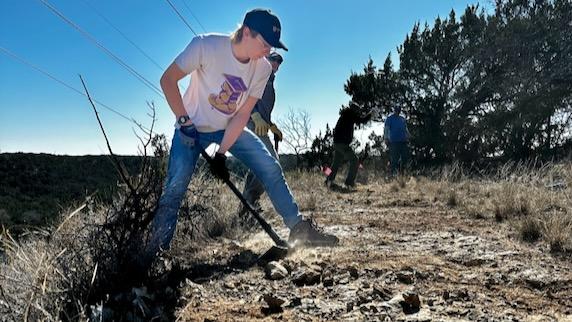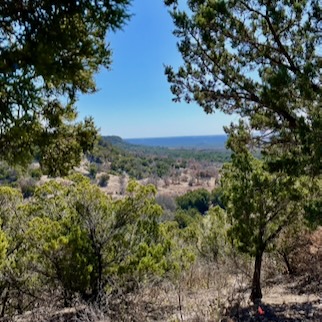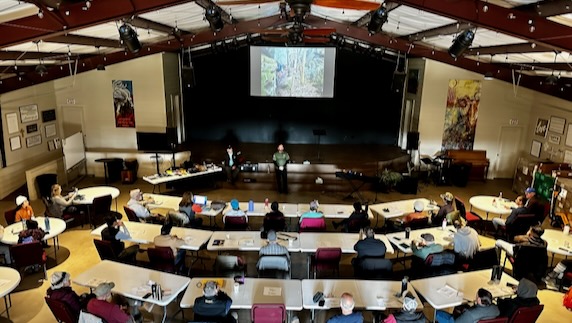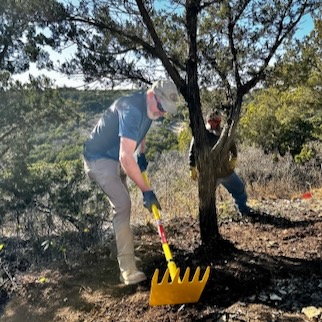
Participants get real world experience at the Lone Star Trail Building School. Photo by Randy Elia.
Making trails was humankind's first activity.
Ancient paths went not just from shelter to food source, but to significant sites such as large trees and vista views. We made trails not just out of necessity, but in search of beauty.
My neighborhood Greenbelt Guild in Dallas is forging trails (with park department permission) in a small strip of woods. The way the team naturally forms sub-teams on their own amazes me, each with a different skill focus: plotting the path, untangling briar thickets, taking down immense privet shrubs.
Some of the skills we shared come from my time in the Lone Star Trail Building School hosted by Greenspace Dallas in Abilene last February. Students and the Greenspace Dallas trail crew carved an off-road bike track from limestone and juniper hills.
The school's next trail building session — Nov. 8 and 9 at Buescher State Park east of Austin — will create a multi-use soft-surface path around a lake. For those who can't scramble to make the fall session, next spring, the LSTBS will be held at Woody Branch Park in Oak Cliff. (See details at end of article.)
THE JOY OF TRAILS
“The trailblazer influences, while the trail follower is influenced.” ― Jeffrey G. Duarte

Trail-making is deeply embedded in human DNA.
"It wasn't the length of the trail. It was the breadth of the experience," wrote Craig D. Lounsbrough.
In making trails, you create experiences for others — positive moments that linger in memory for the peace, joy and even excitement they evoke.
Getting people away from the concrete, deep into a natural environment with clean air and only the sounds of nature, is to return them to their true human selves forged from millions of years of evolution living in harmony with this planet.
To be remembered is to be eternal. As long as people walk the trail your team builds, you will be remembered.
Paraphrasing Maya Angelou — people will never forget how you made them feel.
THE ART OF TRAIL MAKING
“May your trails be crooked, winding, lonesome, a bit dangerous, and leading to the most amazing view.” — Edward Abbey
The Lone Star Trail Building School starts with Saturday morning classroom instruction that is fast and intense. That afternoon, students determine the best route for a trail and mark it, including where route modifications like drainage dips or bridges should go. Sunday morning is trail construction.

Lone Star Trail Building School founder Rick Buckley of Greenspace Dallas (formerly Groundwork Dallas) is the overall boss, organizing work sites and equipment. He keeps a close eye on all teams, correcting and instructing as needed. As ex-military personnel, he's all about teamwork and prioritizing safety, and he gives that instruction. Greenspace Dallas built a nice system of trails at Kiest Park Conservation Area.
Superb trails like these have control points where emergency access is enabled. The trail should meander to offer scenic overlooks, water features, rock outcroppings, fascinating geology, large trees, significant plants, and historical elements. Call them photo opportunities or memory makers.
A good trail should be an expression of the landscape, merging but not dominating.

“We want something that hugs the landscape, fits in nicely, but follows the contour lines for the most part,” said Spakes, while creating enough dips for drainage and interest.
A stacked loop system is optimal when possible. A central or perimeter trail is wide, flat and stroller- and wheelchair-friendly. Narrow-path loops emerge off it, each with a unique element of interest.
But then there is maintaining it.
“Volunteer groups do the majority of trail development across the US and the world. But they often don't have a long-term trail management plan,” said Spakes.
LEARNING ON THE TRAIL
"You are your last line of defense in safety. It boils down to you" — Kina Repp
Our task was to extend an off-road bicycle trail on a ranch near Abilene. Nothing but limestone, juniper and cactus on severe slopes. Because of that, safety was of the utmost importance in trail design and construction. West Texas is not a forgiving landscape.

Students learned how to:
• Read routes of rainwater through the land.
• Detect signs of erosion and route trails away from it.
• Know when creating switchback zig-zags is necessary.
• Create dips and ramps so that water drains from the trail.
“The main thing is for the trail to withstand erosion,” said Spates. “Erosion affects not just the trail, but the area around the trail. We like hiking next to creeks. If the trail that's next to the creek starts to erode, all of that dirt is going to end up in the creek. Sedimentation is problematic for any of the species that live in the creek.”
We spent time in class and on-site learning to use a cool tool called a clinometer.
• Determine if a slope was unsuitably steep for a trail.
• Ensure trails were not dangerously steep.
• Create proper dips and ramps.
Locating better locations was sometimes a matter of a few degrees or feet.
“If we can maintain that sheet flow of water coming down the hillside and crossing the trail and continuing on, it's going to do less damage to our trail in the long run, “ said Spates.
In Buckley's tailgate safety briefings, he informed us:
• What to do if you get injured or if you get too hot or cold, and how to tell.
• Correct body posture for using dirt-moving tools like a shovel or pickax.
• Location of evacuation points for car and helicopter, and the closest hospital.

Buckley stresses constantly maintaining situational awareness by not wearing earbuds and frequently scanning 360 degrees around you.
Essential was learning how to work on a slope so that completing a task doesn't send you rolling downhill. The energy released by wood or rock after completing a cut or dig can send you flying. For that reason, tools are always stashed upslope.
Keeping a swing zone is critical. No one should be within the zone that your extended tool can reach. If taking down a tree, there is a drop zone where it falls that must be kept clear, and consideration must be given to where it might roll.
Hard work at times, but the logic of trail construction truly seeps in. I attended with long-time returning students Hilton Dickerson and Vin Merrill of Friends of LLELA, joined by LLELA trailmaster Leonard Chockrek. Lots of LSTS alumni around to help, which is comforting.
Buckley's Lone Star Trail Building School creates only soft-surface trails. His background is in off-road bicycle trails — he literally wrote the book on it — but has expanded to hiking, trail-running and equestrian activities. Each user has their own drawback:
• Off-road bicyclists create overly steep trails, which cause strong braking that leads to erosion, and use trails when they are muddy.
• Equestrians deposit poop on the trail (especially in the first half-mile) and deep hoof divots from using trails when muddy.
• Hikers make too many unmapped side trails, which get people lost, create erosion-prone paths, and use trails when they are muddy.
Picking up a theme here?: Stay off dirt trails after rain. Go somewhere paved, sandy or rocky.
Watch a video montage of the February 2025 Lone Star Trail Building School near Abeline. Video by Randy Elia.
THE PATHS WE TAKE IN LIFE
“Of all the paths you take in life, make sure a few of them are dirt.” ― John Muir
Places with extensive trail systems attract tourism. Bentonville, Arkansas, brings in $12 million annually to the economy just from trail users, said Spates. Trail systems encourage active people to retire in those locales.

Hiking is the most popular activity in national forests and state parks in Texas. Visitors return from their trips and wonder where the trails are at home. Concrete trails, which are more like roads, are not what they want. According to Texas Parks and Wildlife, stress reduction comes primarily from the immersive experience available on soft trails.
There exists a glut of fit, mostly retired, nature-loving Baby Boomers who've aged out of backpacking and camping. They want to patronize cities where they can hike all day and enjoy a meal and comfy abode that night.
North Texas desperately needs a DORBA-type organization https://www.dorba.org/ for hikers. Without one, soft-surface trail-building will always lag. Precedence for paved trails will always trump soft trails unless an organization specifically for soft trails arises.
Lone Star Trail Building School

About: A program of Greenspace Dallas, the Lone Star Trail Building School is a two-day course held at bi-annually at a Texas nature preserve. Participants learn all aspects of trail building, including design concepts, corridor flagging and construction.
When: Fall session is Nov. 8-9, 2025
Where: Locations vary. The fall session will be held in Buescher State Park in Smithville, Texas.
Cost: $150.
SAVE THE DATE! The Lone Star Trail Building School's spring session — Feb. 27 to March 1 — will focus on constructing soft-surface trails in Woody Branch Park, a Trust for Public Land project in Oak Cliff in partnership with Dallas Parks and Recreation. The nearly 82 acres of high-quality forest are located along the Woody Branch of Five Mile Creek and will tie into the Five Mile Creek Greenbelt. Eventually to become part of city park system.
